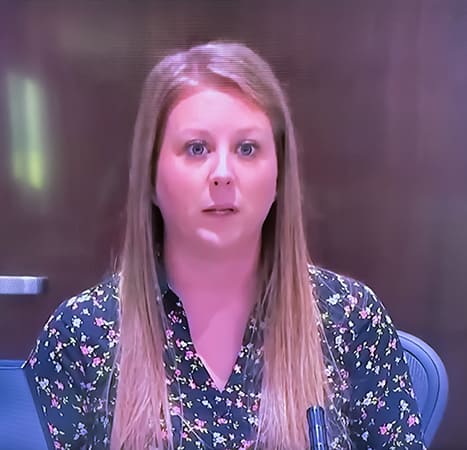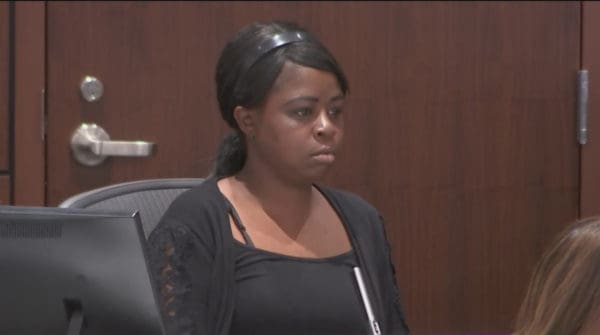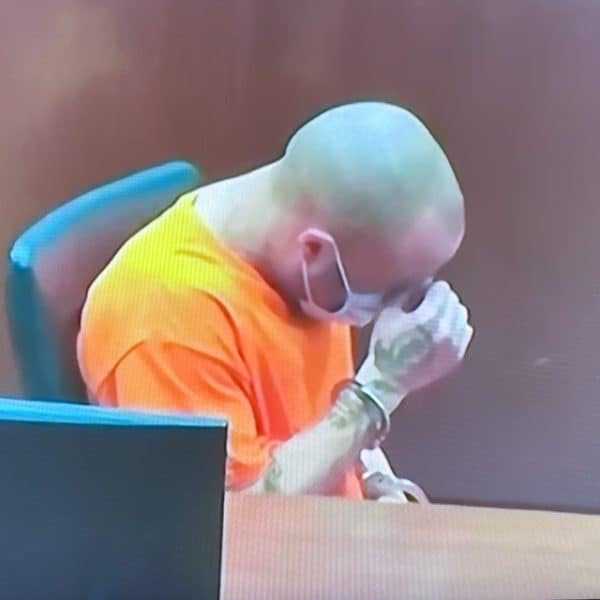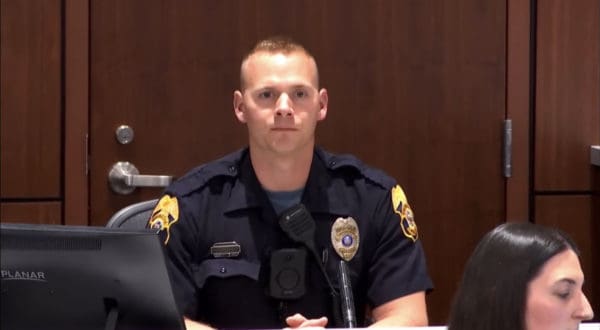The Waukesha Christmas-Parade Trial, Day Two
Anastasia Katz, American Renaissance, October 9, 2022
Darrell Brooks Jr., the Waukesha Christmas parade killer, has been representing himself in his trial, and on Friday, he cross-examined his ex-girlfriend.
Erika Patterson, 32 and black, testified that she has known Darrell Brooks since age 16, when they lived in Reno, Nevada. They have a 15-year-old daughter. Miss Patterson, who now lives in Georgia, went to Waukesha for a two-week visit with Mr. Brooks, where she stayed at his mother’s house. Miss Patterson testified that she and Mr. Brooks were sleeping in the red SUV — later used to kill marchers in the parade — because his mother would not let him in the house. The car belonged to Mr. Brooks’ mother. About two weeks before the Christmas parade, Miss Patterson went to stay at a women’s shelter and became roommates with Kori Runkel, who is white. Miss Runkel testified on Thursday.
On direct, Miss Patterson told the jury that on the day of the killings, she and Mr. Brooks had argued by text all morning. Miss Patterson and Miss Runkel went to Frame Park, where they hung out, drinking. Miss Runkel joined her friend Nick Kirby in the park and the women split up. Mr. Brooks then arrived at the park in his red car, and although the argument from earlier continued, Miss Patterson willingly got into his vehicle. After driving for a bit, Mr. Brooks hit her hard in the eye. She cried and got out. She walked back towards the park, with Mr. Brooks following in his car. She got back into the car, but still afraid, she telephoned Miss Runkel for help. By the time Miss Runkel arrived, Miss Patterson was out of the car again and Mr. Brooks swerved his car very close to her, nearly hitting her. Miss Runkel pulled her out of the way. He got out of the car and pushed Miss Runkel and hit her in the face. He then drove away.
Miss Patterson said that Mr. Kirby called the police. She heard Mr. Kirby talking on the phone, telling the police that Mr. Brooks had a knife, but Mr. Brooks did not have a knife. Miss Patterson thought Mr. Kirby said that to try to get the police to come more quickly.
Mr. Brooks then cross-examined. He was much better behaved than the day before, when his interruptions forced the judge to remove him from the courtroom. He still wore his orange prison suit. He asked Miss Patterson questions about alcohol, including whether she “occasionally drinks too much.” He asked if she knew that there was a rule against alcohol at the women’s shelter. He asked so often about alcohol and took so many objections that Judge Jennifer Dorow ordered him to drop the subject.
Mr. Brooks asked Miss Patterson about their texts and phone conversations. “If the conversation was argumentative, why would you agree to meet up with the defendant?”
“I do not know,” Miss Patterson said, obviously regretting that she had.
He asked, “If there had been an argument, why would you tell the defendant where you were?”
Miss Patterson started to get emotional, but quickly composed herself.
One of Mr. Brooks’ weaknesses in acting as his own lawyer is that he asks open-ended questions that elicit answers that hurt him. For instance, he asked Miss Patterson what her argument with the defendant had been about. “He was arguing about money,” Miss Patterson said, speaking of Mr. Brooks in the third person, “because I did not bail him out.” That told the jury Mr. Brooks has a criminal past, something that was supposed to be left out at trial.
He also asked Miss Patterson if she said anything to make their argument escalate. She said no, and that she was crying the whole time because Mr. Brooks was yelling at her.
He asked what Miss Patterson remembered from their argument, before he drove away. All she remembered was Miss Runkel shouting at him, “Don’t ever hit my F-ing friend again!”
He asked why she had never told the police if he had been abusing her. She said, “Because I’d been dealing with it for so many years, I just didn’t do it.”
He got her to say that a video that had been shown in court did not show the moment that he swerved his car at her, nearly hitting her, but she was able to add that there were videos from two angles, and the other video does show it.
The questioning was tedious and very repetitive. Maybe Mr. Brooks was trying to prolong his time with Miss Patterson, knowing that this was probably the last time he would ever see her. One of the last questions he asked was whether they were in a committed relationship when she came to Waukesha. She said, “Yes.”
The next witness was Detective Steven Guth, who interviewed Miss Patterson and took her in a car, to point out where she had been with Mr. Brooks on the day of the Christmas parade. He showed the jury a map.
When Mr. Brooks cross-examined, he used a strange line of questioning he has used before. He asked if the detective had had any interaction with “the plaintiff.” A plaintiff is the party who initiates a civil lawsuit. There is no plaintiff in a criminal case. The prosecution team had amused smirks on its faces when Mr. Brooks asked Det. Guth, “Do you know if there is a plaintiff in this matter?” The questions about a plaintiff were all objected to by the state, and the judge sustained all them.
Mr. Brooks suggested that Miss Patterson lied to police. He asked if Det. Guth found her to be untruthful, but the reply was no. Mr. Brooks then quoted Det. Guth’s report: “What I learned from Erika Patterson was that when I spoke to her on a previous evening … she was not completely forthright with all the information she had given.” The detective agreed that he wrote that statement, but said Miss Patterson had not lied. He explained that when domestic violence victims make complaints, they don’t always give all the details at first, because they fear retaliation from the abuser.
On the state’s redirect, Det. Guth was asked what Miss Patterson left out when she had not been completely “forthright.” He said that she left out the fact that Mr. Brooks punched her, and added that she had been “extremely afraid” of Mr. Brooks.
On the previous day, Mr. Brooks had suggested he might have Covid-19, perhaps to delay the trial. He said he had been given a Covid test, but that it would take a while to get results. The judge ordered a rapid response test, and when the results came in during the morning’s testimony, they were handed to Mr. Brooks. With the jury out on a break, the judge asked Mr. Brooks to open and read his results. He asked why, and Judge Dorow said, “Mr. Brooks, you raised this issue yourself and I would like to know the result.”
He said that he would too, but he needed to prepare his defense. She said sternly, “Mr. Brooks, find the piece of paper and open it up and read it, please.”
He responded, “Your Honor, I don’t consent to being talked to in that fashion.”
“Your lack of consent is noted for the record,” she said, exasperated. She asked again and he refused, so she cleared the courtroom, went off the record, and asked the sheriff to find the paper.
Back on the record, the judge explained that deputies tried to take the Covid results from Mr. Brooks, “using reasonable force.” There was a struggle, and he was taken to a holding pen for a while. Since he was still upset and yelling that his Constitutional rights had been violated, the judge put him in the secondary courtroom and muted his microphone.
Mr. Brooks’ Covid-19 test was negative. Judge Dorow saw Mr. Brooks shove the results aside when they were given back to him. She decided to take an early lunch so he could review his test results. She stated that he made responsible, articulate objections during witness testimony, and that he was competently representing himself in the morning, so she wanted to give him a chance to cool off in the other court room while they were at lunch. When she announced the break, Mr. Brooks cried.
When court resumed, Mr. Brooks was back in the main courtroom, sulking behind his table. He sniffled and held a rumpled tissue. He had a box of tissues near him. Since the trial began, he has had big white boxes of discovery documents on his table in the courtroom. He now had a Bible with him as well.
The first witness after lunch was Officer Jeremy Philipps of the Waukesha PD. On November 21, 2021, he was on general patrol. He was dispatched with lights and sirens to Frame Park at 4:52 pm, for subjects fighting, allegedly with a knife. As Officer Philipps was questioned, Mr. Brooks put his head down and trembled, crying.
The officer recalled going to a location in Frame Park where he believed there was a knife fight. He was looking for anyone suspicious or anyone in need of help. He heard on his radio that a reserve officer (a volunteer doing security for the Christmas parade) was already talking to someone who was involved, so he drove to that location, where three people were trying to flag him down. When he rolled down his passenger window, two people shouted to him that their friend had been assaulted. At the same time, he heard on his radio that someone had been hit downtown.
He spoke to a short black woman and two others. The black woman said she was fine and just wanted to leave, but her friends said, “No, Erika, you have to tell him what happened.”
Officer Philipps took Erika Patterson’s name, but was distracted by his radio, which blasted “10-78” calls. He said that code means “officer needs immediate assistance, all available units.” He was hearing about more and more people being down, first 10, then 40. He decided he had to leave because the situation downtown was so urgent. He apologized to Erika and left.
Officer Philipps recalled that when he got to Main Street, “there was mass chaos, carnage everywhere.” He tried to help everyone he could. He spoke to members of a high school band. A number of bandsmen were lying injured on the ground. Parents were screaming at him to help their children. He gave emergency first aid. He heard that a vehicle had driven through the parade. A girl with an injured leg, who was being held up by her parents, told the officer, “I saw what happened! A red SUV did this!”
The officer said the victims were all teenagers in a high school band. He learned from radio traffic that a man named Darrell Brooks had been taken into custody.
When he followed up with Miss Patterson, he found out that she was linked to Darrell Brooks, and Mr. Brooks was linked to a red SUV. When it was Mr. Brooks’ turn to cross-examine the officer, he asked if he was being paid for his testimony. Officer Philipps replied that he was employed by the Waukesha Police Department. Court appearances are part of an officer’s job.
Mr. Brooks then veered into his “plaintiff” questions. “Were you subpoenaed to testify by the plaintiff?” Officer Philipps said he was subpoenaed by the Waukesha County Prosecutor’s office.
When Mr. Brooks asked if he knew if there was a plaintiff in this case, Officer Philipps replied, “I was contacted by the Waukesha County District Attorney’s office to testify in this case.”
“Do you know if that’s the plaintiff in this matter?” Mr. Brooks asked. He seemed to be sincerely curious.
“Generally, in a criminal case,” the officer replied, “the plaintiff would be the state of Wisconsin. That is my assumption in this case, that the plaintiff is the state of Wisconsin.”
From that point on, Mr. Brooks began asking a similar set of questions to every witness, but instead of asking about “the plaintiff,” he asked about the state of Wisconsin: “Did the State of Wisconsin subpoena you?” “Do you see the state of Wisconsin in the courtroom today?” “Did you ever have a phone conversation with the State of Wisconsin?”
This raises questions: Is he feigning insanity? Is he stalling for time? Is he mocking the lawyers? Is he trying to sound like a lawyer? Does he think someone is out to get him, and is trying to figure out who that is?
The next witness was Kyle Edwards, a Waukesha resident who was driving to the parade with his wife and two children. They stopped at an intersection, and a red SUV turned the wrong way on one-way North Street. He could see the driver put his hands up in a gesture that suggested it was Mr. Edwards who had gone the wrong way. The driver motioned to a gas station parking lot, and Mr. Edwards backed up to let the red SUV drive into it.
The driver called to Mr. Edwards, “Why didn’t you get out of the way? I need to get gas!”
“You’re going to wrong way down a one-way.”
“Well, I need to get gas!”
Mr. Brooks was told to take his mask off, and Mr. Edwards identified him as the driver of the red SUV, but he mentioned that Mr. Brooks had more hair at that time.
Mr. Edwards and his family went to watch the parade, though they were several rows back and did not have a good view. He saw a red SUV speeding in from the left, and saw a person fly through the air. He went to help at the accident scene while his wife took the children home.
Holly Berg, another witness, was stopped at a traffic light on North Street when she saw a red SUV go towards the gas station. A silver car was in the exit of the gas station. She saw the red car stop and its driver stuck his head out the window and yelled at the driver of the silver car. She identified Mr. Brooks as that driver.

Holly Berg
She described seeing the same red SUV on the parade route. At first she thought it was part of the parade, but then realized it was going too fast. It collided with a group in front of her. She said she saw at least 15 people get hit. She heard thuds and saw people “in the air like bowling pins.” She could clearly see Darrell Brooks in the driver’s seat. “I froze and said to my mother who was with me, ‘I just saw that guy at the gas station!’”
Detective Thomas Casey, the last witness of the day, spent a lot of time reviewing videos. There were videos of the parade before Mr. Brooks drove through, and videos from after the crash, with dead and wounded on the street. Mr. Brooks will cross-examine detective Casey when the trial resumes on Monday.
The jury is not sequestered, and the judge gave instructions not to discuss the case with anyone, try to learn about it in any way, or visit the scene.


















